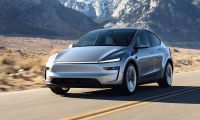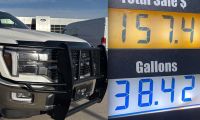A CNN reporter has one-up'd the NY Times' John Broder by successfully driving a Tesla Model S from Washington D.C. to Boston, in the middle of the winter, where Broder failed to make the same trip last week. According to a report published on Friday, Peter Valdes-Dapena of CNN Money not only made the trip but did so easily with plenty of energy to spare. Broder's trip famously ended with the Model S on a flatbed tow truck.
Valdes-Dapena took the trip in one day on Thursday, rather than Broder's plan to split it over two days with an overnight stop in a hotel. For the CNN reporter the "most scarey" part of the trip was the 200 miles between Newark, Del., and Milford, Conn. While the Tesla Model S has either a 240 mile or 260+ mile driving range (by default the car is configured for a 90% recharge, giving 240 miles of range) that isn't much cushion given that the distance between those stations is 200 miles.
The 85 kilowatt-hour Tesla Model S has an EPA certified range of 265 miles. The Tesla Supercharger stations can give the car a complete recharge in about an hour. Tesla plans to, over the next few years, build out a network of these charging stations criss-crossing the country. Along the East Coast corridor, they'll shortly build more stations making the Washington-Boston trip even easier.
For a write-up of Broder's ill fated trip see Tesla Motors fires back at NY Times John Broder over failed Model S test drive
Valdes-Dapena reports having followed Tesla's energy saving instructions carefully, to keep the cruise control between 60-65 miles/hr and the climate control at 72 degrees F. That let him sit in the middle lane of traffic and keep up with traffic very nicely. In Northern New Jersey he had a choice of two routes through New York City, one would be to drive through the City and potentially run into heavy traffic, the other was to swing north on a 30 miles longer route that was likely to avoid traffic. He chose the longer route, and ran into heavy traffic anyway.
However on getting into Connecticut he had plenty of range to spare, and decided to play with the car, mashing the accelerator pedal to feel acceleration from 65 to 80 miles/hr. It made him giddy. We understand.
The second part of the trip from Milford to Boston was so unremarkable that he didn't even mention it. According to Google Maps there are three routes from Milford to Boston, the shortest is 140 miles and has lots of public charging stations along the way. The other two are 160ish miles and have fewer public charging stations along the way.
This result from the CNN reporter casts even more doubt on the NY Times report by John Broder. Why did the CNN reporter seemingly have an incredibly easy time of the trip, when Broder had a hard time? We should note that earlier this week when Elon Musk was tweeting, one of the tweets called for other reporters to replicate Broder's trip. Maybe the CNN reporter was simply better instructed than Broder was?
In Broder's responses he has yet to explain two things: Why did he fail to fully charge the Model S in Milford Conn.? He left that charging station with a 73% charge costing him about 70 miles of range. Second, why did he take the longer route to Boston? Traveling through Norwich is, according to Google Maps, a 163 mile distance from Milford to Boston, while another route only requires 140 miles.
That the CNN reporter took the trip in one day meant his Model S did not spend overnight in 10-20 degrees F weather. According to Broder that sapped 60 miles or so of range and was the second issue that endangered his trip. However it's likely most of that range will have been recovered when the battery pack warmed up, had Broder simply started driving.
Another difference is the ambient temperature on Thursday was a bit warmer than last week during Broder's trip. As we saw with Broders trip, the cold weather did affect the car's performance. However, Tesla Motors claims they have customers in all kinds of cold climates and that the cold weather effects should not be that significant.
Whether this creates enough doubt to undermine the NY Times report remains to be seen.
Source: CNN.COM











